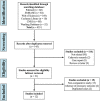Unilateral biportal endoscopic lumbar interbody fusion enhanced the recovery of patients with the lumbar degenerative disease compared with the conventional posterior procedures: A systematic review and meta-analysis
- PMID: 36703632
- PMCID: PMC9871470
- DOI: 10.3389/fneur.2022.1089981
Unilateral biportal endoscopic lumbar interbody fusion enhanced the recovery of patients with the lumbar degenerative disease compared with the conventional posterior procedures: A systematic review and meta-analysis
Abstract
Background: Minimally invasive endoscopic technique is an important component of Enhanced Recovery After Surgery (ERAS) protocol for neurosurgery. In recent years, unilateral biportal endoscopic lumbar interbody fusion (ULIF) has been used in the treatment of lumbar degenerative diseases (LDD). This study aims to investigate whether ULIF could enhance the recovery of patients with LDD compared with the conventional minimally invasive transforaminal lumbar interbody fusion (MI-TLIF) or posterior lumbar interbody fusion (PLIF).
Methods: A comprehensive literature search was performed for relevant studies in PubMed, EMBASE, Web of Science, Cochrane Library database, China National Knowledge Internet, and Wanfang database. Surgical data, clinical outcomes, radiographic outcomes, and surgical complications were compared between patients with LDD who underwent ULIF and those who underwent conventional MI-TLIF or PLIF.
Results: Notably, 12 studies, comprising 981 patients with LDD, were included. Of these patients, 449 underwent ULIF and 532 patients (355 MI-TLIF and 177 PLIF) were treated with conventional procedures. There was no significant difference in the fusion rate, cage subsidence rate, and surgical complications between the ULIF group and the MI-TLIF or PLIF group. Compared with MI-TLIF, the ULIF group presented a significantly reduced estimated blood loss (EBL) (WMD, -106.00; 95% CI -140.99 to -71.10, P < 0.001) and shorter length of hospital stay (LOS) (WMD, -1.27; 95% CI -1.88 to -0.66, P < 0.001); better short-term improvement in ODI (WMD, -2.12; 95% CI -3.53 to -0.72, P = 0.003) and VAS score for back pain (VAS-BP) (WMD, -0.86; 95% CI -1.15 to -0.58, P < 0.001) at 1 month post-operatively. Compared with PLIF, the ULIF group presented a significantly reduced EBL (WMD, -149.22; 95% CI -284.98 to -13.47, P = 0.031) and shorter LOS (WMD, -4.40; 95% CI -8.04 to -0.75, P = 0.018); better short-term improvement in VAS-BP (WMD, -1.07; 95% CI -1.77 to -0.38, P = 0.002) and VAS score for leg pain (VAS-LP) (WMD, -0.40; 95% CI -0.72 to -0.08, P = 0.014) at 1-2 week post-operatively; enhanced short- and long-term improvement in ODI at 1 month post-operatively (WMD, -3.12; 95% CI -5.72 to -0.53, P = 0.018) and the final follow-up (WMD, -1.97; 95% CI -3.32 to -0.62, P = 0.004), respectively.
Conclusion: Compared with conventional MI-TLIF and PLIF, ULIF was associated with reduced EBL, shorter LOS, and comparable fusion rate as well as complication management. Compared with MI-TLIF, a better short-term improvement in VAS-BP and ODI was achieved by ULIF; compared with open PLIF, additional enhanced short-term improvement in VAS-LP and long-term improvement in ODI were observed in ULIF. ULIF could enhance the recovery of patients with LDD compared with conventional posterior procedures.
Systematic trial registration: https://www.crd.york.ac.uk/prospero/display_record.php?RecordID=230695, CRD42021230695.
Keywords: Enhanced Recovery After Surgery; lumbar degenerative disease; minimally-invasive transforaminal lumbar interbody fusion; neurosurgery; posterior lumbar interbody fusion; unilateral biportal endoscopic lumbar interbody fusion.
Copyright © 2023 Yang, Cheng, Hai, Liu and Pan.
Conflict of interest statement
The authors declare that the research was conducted in the absence of any commercial or financial relationships that could be construed as a potential conflict of interest.
Figures











Similar articles
-
Unilateral biportal endoscopic lumbar interbody fusion versus minimally invasive transforaminal lumbar interbody fusion for single-segment lumbar degenerative disease: a meta-analysis.BMC Musculoskelet Disord. 2024 Nov 21;25(1):938. doi: 10.1186/s12891-024-08046-0. BMC Musculoskelet Disord. 2024. PMID: 39574056 Free PMC article.
-
Comparison of mid-term outcomes between unilateral biportal endoscopic and minimally invasive transforaminal lumbar interbody fusion in the treatment of single-level lumbar degenerative disease.PLoS One. 2025 Apr 29;20(4):e0321569. doi: 10.1371/journal.pone.0321569. eCollection 2025. PLoS One. 2025. PMID: 40299897 Free PMC article.
-
Clinical outcomes of unilateral biportal endoscopic lumbar interbody fusion (ULIF) compared with conventional posterior lumbar interbody fusion (PLIF).Spine J. 2023 Feb;23(2):271-280. doi: 10.1016/j.spinee.2022.10.001. Epub 2022 Oct 15. Spine J. 2023. PMID: 36252809
-
Unilateral biportal endoscopic lumbar interbody fusion (ULIF) versus minimally invasive transforaminal lumbar interbody fusion (MI-TLIF) for the treatment of degenerative lumbar spondylolisthesis: a retrospective analysis.BMC Musculoskelet Disord. 2025 May 28;26(1):526. doi: 10.1186/s12891-025-08777-8. BMC Musculoskelet Disord. 2025. PMID: 40437446 Free PMC article.
-
Short-term clinical efficacy and safety of unilateral biportal endoscopic transforaminal lumbar interbody fusion versus minimally invasive transforaminal lumbar interbody fusion in the treatment of lumbar degenerative diseases: a systematic review and meta-analysis.J Orthop Surg Res. 2023 Sep 4;18(1):656. doi: 10.1186/s13018-023-04138-0. J Orthop Surg Res. 2023. PMID: 37667363 Free PMC article.
Cited by
-
Comparison of the clinical outcomes of VBE-TLIF versus MIS-TLIF for single-level degenerative lumbar diseases.Eur Spine J. 2024 Mar;33(3):1120-1128. doi: 10.1007/s00586-023-08096-3. Epub 2024 Feb 13. Eur Spine J. 2024. PMID: 38347273
-
Comparison of short-term effectiveness between unilateral biportal endoscopic and MED-assisted transforaminal lumbar interbody fusion for mild single-segment lumbar spondylolisthesis.BMC Musculoskelet Disord. 2025 Jul 4;26(1):631. doi: 10.1186/s12891-025-08892-6. BMC Musculoskelet Disord. 2025. PMID: 40615825 Free PMC article.
-
Evaluation of the learning curve and complications in unilateral biportal endoscopic transforaminal lumbar interbody fusion: cumulative sum analysis and risk-adjusted cumulative sum analysis.J Orthop Surg Res. 2024 Mar 21;19(1):194. doi: 10.1186/s13018-024-04674-3. J Orthop Surg Res. 2024. PMID: 38509573 Free PMC article.
-
Advances in minimally invasive surgical techniques for lumbar disc herniation: a comprehensive review.Front Surg. 2025 Jun 17;12:1593195. doi: 10.3389/fsurg.2025.1593195. eCollection 2025. Front Surg. 2025. PMID: 40599223 Free PMC article. Review.
-
Preserving Cervical Mobility: A Novel Robot-Assisted Approach for Atlas Fracture Fixation.Am J Case Rep. 2025 Jan 25;26:e945718. doi: 10.12659/AJCR.945718. Am J Case Rep. 2025. PMID: 39861930 Free PMC article.
References
Publication types
LinkOut - more resources
Full Text Sources

